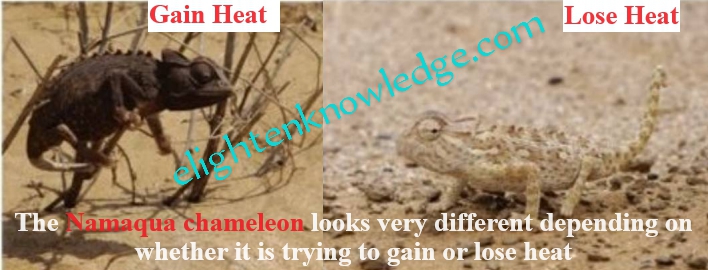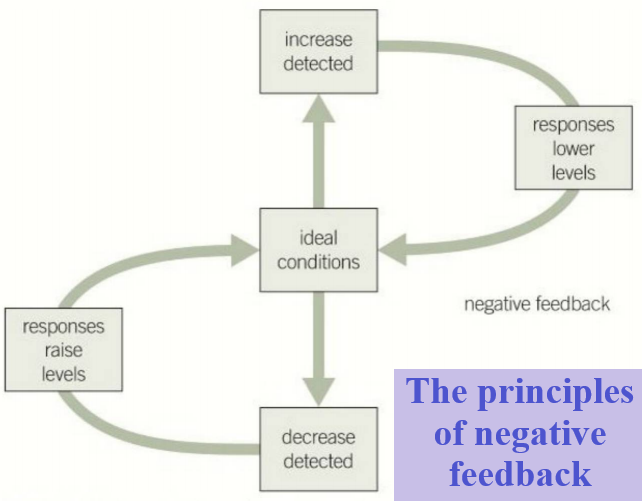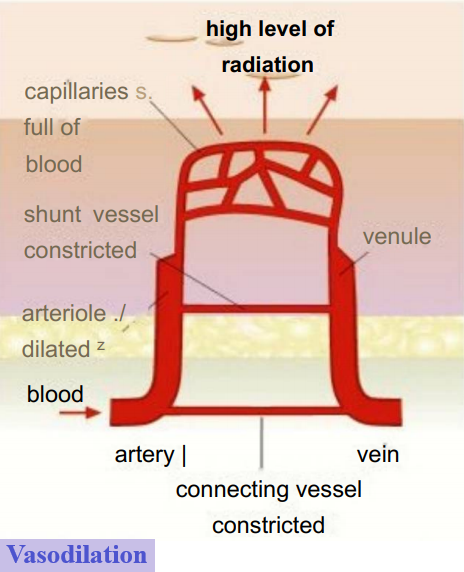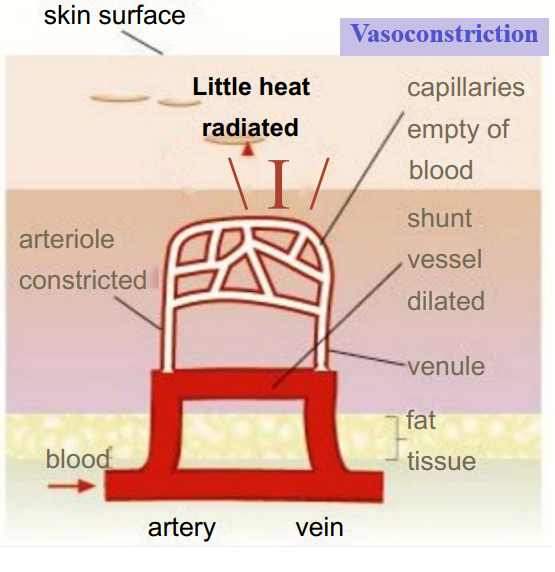Understanding the Principle of Homeostasis and Thermoregulation.

Understanding the Principle of Homeostasis and Thermoregulation.
Content:
The principles of homeostasis
Receptors and effectors
Feedback systems
- Negative feedback systems
- Positive feedback systems
Thermoregulation
Classification of animals based on thermoregulation
- Endotherms
- Ectotherms
How ectotherms and endotherms maintain and control their body temperature.
- Temperature regulation in ectotherms
- Physiological responses to warming
- Detecting temperature changes in endotherms
- Principles of thermoregulation in endotherms
Mechanism used by endotherms cool down their body
- Vasodilation
- Increased sweating
- Reducing the insulating effect of hair or feathers
How endotherms warm up their body
- Vasoconstriction
- Decreased sweating
- Raising the body hair or feathers
- Shivering
Controlling thermoregulation
- The heat loss centre
- The heat gain centre
The principles of homeostasis
The enzyme-controlled reactions of life can only take place if the conditions are right.
The concentration of chemicals such as glucose and sodium ions must be kept within a narrow range, as must the pH and water balance of the body fluids, and the core temperature of the body.
Organisms use both chemical and electrical systems to monitor and respond to any changes from the steady state of the body, and use the information to maintain a dynamic equilibrium.
Receptors and effectors
It is impossible to maintain a living mammal in a completely stable state because everything causes minute changes.
Instead, the body maintains a dynamic equilibrium, with small fluctuations over a narrow range of conditions.
This is known as homeostasis.
Receptors and effectors are vital for the body to maintain this dynamic equilibrium.
As you have seen, sensory receptors detect changes in the internal and external environment of an organism.
In homeostasis, it is essential to monitor changes in the internal environment.
For example,
- the pH of the blood,
- core body temperature,
- and concentrations of urea and sodium ions in the blood.
Information from the sensory receptors is transmitted to the brain and impulses are sent along the motor neurones to the effectors to bring about changes to restore the equilibrium in the body.
Effectors are the muscles or glands that react to the motor stimulus to bring about a change in response to a stimulus.
Both are vital in a homeostatic system because detecting change is no use without the means to react to that change, but effectors cause chaos unless responding to a need.
Feedback systems
- Homeostasis depends on sensory receptors detecting small changes in the body, and effectors working to restore the status quo.
- These precise control mechanisms in the body are based on feedback systems that enable the maintenance of a relatively steady state around a narrow range of conditions.
Negative feedback systems
- Most of the feedback systems in the body involve negative feedback.
- A small change in one direction is detected by sensory receptors.
- As a result, effectors work to reverse the change and restore conditions to their base level.
- Negative feedback systems work to reverse the initial stimulus.
- You have seen negative feedback in action in the control of blood sugar levels by insulin and glucagon.
- Negative feedback systems are also important in many other aspects of homeostasis including temperature control and the water balance of the body.

Positive feedback systems
- There are relatively few positive feedback systems in the body.
- In a positive feedback system, a change in the internal environment of the body is detected by sensory receptors, and effectors are stimulated to reinforce that change and increase the response.
- One example occurs in the blood clotting cascade.
- When a blood vessel is damaged, platelets stick to the damaged region and they release factors that initiate clotting and attract more platelets.
- These platelets also add to the positive feedback cycle and it continues until a clot is formed.
- Another example of a positive feedback mechanism is seen during childbirth.
- The head of the baby presses against the cervix, stimulating the production of the hormone oxytocin.
- Oxytocin stimulates the uterus to contract, pushing the head of the baby even harder against the cervix and triggering the release of more oxytocin.
- This continues until the baby is born.

Thermoregulation
- The enzymes controlling the rates of the chemical reactions needed for life are very temperature sensitive.
- Each enzyme has an optimum temperature at which it works most efficiently.
- If the temperature gets too high the enzymes are denatured.
- An important aspect of homeostasis in many animals is the maintenance of a relatively constant core body temperature to maintain optimum enzyme activity.
- This process is known as thermoregulation.
Endotherms and ectotherms
Organisms are constantly heating up and cooling down as a result of their surroundings.
These changes depend on a number of physical processes. These include:
- Exothermic chemical reactions.
- Latent heal of evaporation – objects cool down as waler evaporates from a surface.
- Radiation – the transmission of electromagnetic waves to and from the air, water, or ground.
- Convection – the heating and cooling by airrents of air or water, warm air or water rises and cooler air or water sinks setting up convection currents around an organism.
- Conduction – heating as a result of the collision of molecules. Air is not a good conductor of heal but the ground and water are.
In many cases, the balance between heating and cooling determines the core temperature of the organism.
Animals can be classified as
- ectotherms
- or endotherms
depending on how they maintain and control their body temperature.
Ectotherms
Most animals are ectotherms and use their surroundings to warm their bodies (ectotherm literally means ‘outside heat’).
Their core body temperature is heavily dependent on their environment.
Ectotherms include;
- all the invertebrate animals,
- along with fish,
- amphibians,
- and reptiles.
Moreover, many ectotherms living in water do not need to thermoregulate.
The high heat capacity of water means that the temperature of their environment does not change much.
Ectotherms that live on land have a much bigger problem with temperature regulation.
The temperature of the air can vary dramatically both between seasons and even over a 24-hour period from the middle of the day to the end of the night.
As a result, ectotherms have evolved a range of strategies that enable them to cool down or warm up.
Endotherms
- Mammals and birds are endotherms.
- They rely on their metabolic processes to warm up and they usually maintain a very stable core body temperature regardless of the temperature of the environment (endotherm literally means ‘inside heat’).
- They have adaptations which enable them to maintain their body temperature and to take advantage of warmth from the environment.
- As a result, endotherms survive in a wide range of environments.
- Keeping warm in cold conditions and cooling down in hot conditions arc both active processes.
- The metabolic rate of endotherms is around five times higher than ectotherms, so they need to consume more food to meet their metabolic needs than ectotherms of a similar size.
Temperature regulation in ectotherms
- Ectotherms cannot control their body temperature using their metabolism however, they have evolved an external temperature range of behavioural responses that enable them to overcome the limitations imposed by the temperature of their surroundings.
Behavioural responses employed by ectotherms
- Ectotherms display a number of behaviours which increase or reduce the radiation they absorb from the Sun.
- Sometimes they need to warm up to reach a temperature at which their metabolic reactions happen fast enough for them to be active.
- They may bask in the Sun, orientate their bodies so that the maximum surface area is exposed to the
- Sun, and even extend areas of their body to increase the surface area exposed to the Sun.
For example,
- lizards often bask for long periods of time to get warm enough to move fast and hunt their prey.
- insects such as locusts and butterflies orientate themselves for maximum exposure to the Sun and spread their wings to increase the available surface area to gel warm enough to fly.
Ectotherms can increase their body temperature through conduction by pressing their bodies against the warm ground.
They also get warmer as a result of exothermic metabolic reactions.
Galapagos iguanas will contract their muscles and vibrate increasing cellular metabolism to raise their body temperature.
Similarly, moths and butterflies may vibrate their wings to warm their muscles before they lake flight.
Ectotherms sometimes need to cool down to prevent their core temperature reaching a point where enzymes begin to denature.
To cool down, many of the warming processes are reversed.
Ectotherms shelter from the sun by seeking shade, hiding in cracks in rocks, or even digging burrows.
They will press their bodies against cool, shady earth or stones, or move into available waler or mud.
They orientate their bodies so that the minimum surface area is exposed to the sun, and minimise their movements to reduce the metabolic heat generated.
Physiological responses to warming in ectotherms
- Much of the thermoregulation by ectotherms is the result of behavioural responses but some of them have physiological responses as well.
- Dark colours absorb more radiation than light colours.
- Lizards living in colder climates tend to be darker coloured than lizards living in hotter countries so that they get warmer.
- Some ectotherms also alter their heart rate to increase or decrease the metabolic rate and sometimes to affect the warming or cooling across the body surfaces.
- Ectotherms are always more vulnerable to fluctuations in the environment than endotherms.
- However, by using a variety of behavioural and physiological strategies many of them can maintain relatively stable core temperatures.
- They need less food than endotherms as they use less energy regulating their temperatures, and so they can survive in some very difficult habitats where food is in short supply.
A highly adapted ectotherm is the Namaqua chameleon
The Namaqua chameleon lives in the Namib desert, one of the most inhospitable hot and waterless environments on Earth.
Several observations have been made on this rare and extremely well-adapted ectotherm:
- It is black in the morning. It may even appear black on the side exposed to the sun and pale grey on the other side of the body.
- It orientates its body sideways to the Sun.
- It has an increased heart rate early in the morning when basking.
- It inflates its body in the early morning.
- It presses its body to the desert sand in the morning.
- During the day the chameleon deflates its body.
- The animal becomes a very pale grey.
- It holds itself well away from the desert surface.
- The heart rate slows down.
- The chameleon opens its mouth and pants in the middle of the day.
Thermoregulation in endotherms
Endotherms can regulate their body temperature within a very narrow range in a wide variety of external conditions.
Human beings, like all mammals, have a number of physiological responses that make this thermoregulation possible.
Detecting temperature changes
- In any homeostatic system receptors are needed to detect a change in the internal environment.
- The peripheral temperature receptors are in the skin and detect changes in the surface temperature.
- Temperature receptors in the hypothalamus detect the temperature of the blood deep in the body.
- The temperature of the skin is much more likely to be affected by external conditions than the temperature of the hypothalamus.
- The combination of the two gives the body great sensitivity and allows it to respond not only to actual changes in the temperature of the blood but to prompt possible problems that might result from changes in the external environment.
- The temperature receptors in the hypothalamus act as the thermostat of the body, controlling the responses that maintain the core temperature in a dynamic equilibrium to within about 1 °C of 37°C.
Principles of thermoregulation in endotherms
Endotherms use their internal exothermic metabolic activities to keep them warm, and energy requiring physiological responses to help them cool down.
They also have passive ways of heating up and cooling down, to reduce the energy demands on their bodies.
Like ectotherms, endotherms have a range of behavioural responses to temperature changes that include
- basking in the Sun,
- pressing themselves to warm surfaces,
- wallowing in water and mud to cool down,
- and digging burrows to keep warm or cool.
Some animals even become dormant through the coldest weather (hibernation) or through the hottest weather (aestivation is a period of prolonged or deep sleep similar to hibernation but occurs in summer or during dry seasons to avoid heat stress rather than cold).
Humans have additional behavioural adaptations to help control body temperature;
- clothes are worn to stay warm,
- houses are built, and then heated up or cooled down to maintain the ideal temperature.
In spite of these behavioural responses, endotherms mainly rely on physiological adaptations to maintain a stable core body temperature, regardless of the environmental conditions or the amount of exercise being done.
These adaptations include the use of;
- the peripheral temperature receptors,
- the thermoregulatory centres of the hypothalamus,
- the skin, and muscles.
How endotherms cool down their body
If the core body temperature increases it is important for an animal to cool down.
There are a number of rapid responses to a rise in the core temperature that are common to all endotherms.
These include:
Vasodilation
- The arterioles near the surface of the skin dilate when the temperature rises.
- The vessels that provide a direct connection between the arterioles and the venules (the arteriovenous shunt vessels) constrict.
- This forces blood through the capillary networks close to the surface of the skin.
- The skin flushes, and cools as a result of increased radiation.
- If the skin is pressed against cool surfaces, then the cooling results from conduction.

Increased sweating
- As the core temperature starts to increase, rates of sweating also increase.
- Sweat spreads out across the surface of the skin.
- In some mammals, including humans and horses, there are sweat glands all over the body.
- As the sweat evaporates from the surface of the skin, heat is lost, cooling the blood below the surface.
- In some animals, the sweat glands are restricted to the less hairy areas of the body such as the paws.
- These animals often open their mouths and pant when they get hot, again losing heat as the water evaporates.
- In human beings, around 1 dm3 of sweat is lost by evaporation on a normal day.
- If the conditions are very hot and dry or the person is exercising very hard, up to 12 dm3 of sweat a day can be lost.
- Kangaroos and cats often lick their front legs to keep cool in high temperatures.
Reducing the insulating effect of hair or feathers
- As the body temperature begins to increase, the erector pili muscles (the hair erector muscles) in the skin relax as a result, the hair or feathers of the animal lie flat to the skin.
- This avoids trapping an insulating layer of air.
- It has little effect in humans.
- Endotherms that live in hot climates often have anatomical adaptations as well as the behavioural and physiological adaptations already described.
- These minimise the effect of high temperatures and maximise the ability of the animal to cool down through the surface area of the body.
- They include a relatively large surface area to volume (SA: V) ratio to maximise cooling (e.g., include large ears and wrinkly skin), and pale fur or feathers to reflect radiation.
How endotherms warm up their body
If the core temperature falls it is important for an animal to warm up and prevent further cooling.
There are a number of rapid responses to a fall in the core temperature that are common to all endotherms.
Vasoconstriction
- The arterioles near the surface of the skin constrict.
- The arteriovenous shunt vessels dilate, so very little blood flows through the capillary networks close to the surface of the skin.
- Causing the skin looks pale, and very little radiation takes place.
- The warm blood is kept well below the surface.

Decreased sweating
As the core temperature falls, rates of sweating decrease and sweat production will stop entirely.
This greatly reduces cooling by the evaporation of water from the surface of the skin, although some evaporation from the lungs still continues.
Raising the body hair or feathers
- As the body temperature falls, the erector pili muscles in the skin contract, pulling the hair or feathers of the animal erect.
- This traps an insulating layer of air and so reduces cooling through the skin.
- The effect can be quite dramatic and it is a very effective way to reduce heat loss to the environment in many animals.
- In humans this has little effect although you can observe the hairs being pulled upright.
Shivering
- As the core temperature falls the body may begin to shiver.
- This is the rapid, involuntary contracting and relaxing of the large voluntary muscles in the body.
- The metabolic heat from the exothermic reactions warms up the body instead of moving it and is an effective way of raising the core temperature.
- Endotherms living in cold climates often have additional anatomical adaptations to help them keep warm.
- Many have adaptations that minimise their SA: V ratio to reduce cooling (e.g., small ears).
- Another common adaptation is a thick layer of insulating fat underneath the skin.
- For example,
- blubber in whales and seals.
- Some animals hibernate they build up fat stores, build a well-insulated shelter, and lower their metabolic rate so they pass the worst of the cold weather in a deep sleep-like state.
Polar bears demonstrate many of the ways in which endotherms can survive in extremely cold conditions.
- They have small hairs and fur on their feet to insulate them from the ice.
- The fur and skin of polar bears work together.
- The hairs are hollow so trap a permanent layer of insulating air.
- The skin underneath is black, so it absorbs warming radiation.
- They have a thick layer of fat under the skin.
- Polar bears are so well insulated that their external surfaces are similar in temperature to the snow and ice on which they live.
- Females dig dens in the snow and remain in them, warm and insulated, for months while they give birth to their cubs, only emerging when the cubs are large enough to survive the cold.
- Polar bears are so well adapted to life in temperatures down to -50 °C in the Arctic that they can overheat at temperatures over 10 °C.
Controlling thermoregulation
The physiological responses of endotherms to changes in the core temperature are the result of complex homeostatic mechanisms involving negative feedback control from the hypothalamus. There are two control centres:
The heat loss centre
- This is activated when the temperature of the blood flowing through the hypothalamus increases.
- It sends impulses through autonomic motor neurones to effectors in the skin and muscles, triggering responses that act to lower the core temperature.
The heat gain centre
- This is activated when the temperature of the blood flowing through the hypothalamus decreases.
- It sends impulses through the autonomic nervous system to effectors in the skin and the muscles, triggering responses that act to raise the core temperature.
- The interaction of the sensory receptors, the autonomic nervous system, and the effectors in a sophisticated feedback system enables endotherms to maintain a very stable core body temperature regardless of environmental conditions or activity levels.
Join Enlighten Knowledge WhatsApp platform.
Join Enlighten Knowledge Telegram platform.





